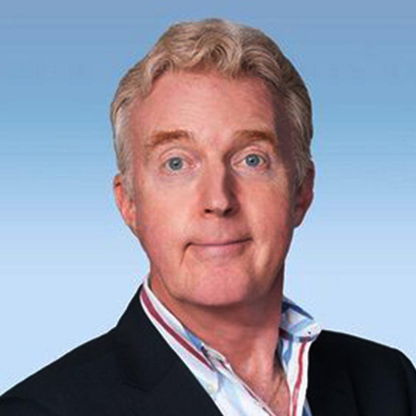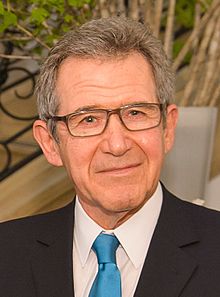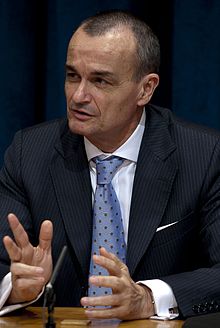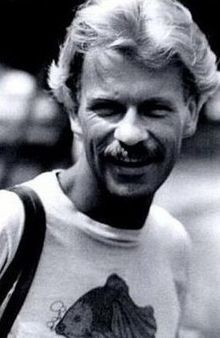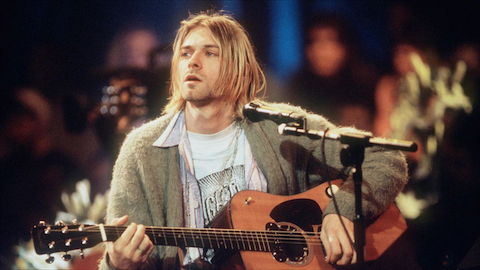|
presents THIS DAY IN GAY HISTORY based on: The White Crane Institute's 'Gay Wisdom', Gay Birthdays, Gay For Today, Famous GLBT, glbt-Gay Encylopedia, Today in Gay History, Wikipedia, and more …
Collected by Ted February 20 [{(o)}]|[{(o)}]|[{(o)}]|[{(o)}]| [{(o)}]|[{(o)}] 1775 – In Frisia, the Netherlands, two teenage servants are banished for three years for "toleration of sodomy."
1852 – Delaware eliminates the flogging penalty for sodomy and substitutes time in the pillory before imprisonment.
1872 – William Lygon, Seventh Earl Beauchamp, (d.1938), was a British Liberal politician. He was Governor of New South Wales between 1899 and 1901, a member of the Liberal administrations of Sir Henry Campbell-Bannerman and H. H. Asquith between 1905 and 1915 and leader of the Liberal Party in the House of Lords between 1924 and 1931. When political enemies threatened to make public his homosexuality he resigned from office to go into exile. Lord Beauchamp is generally supposed to have been the model for Lord Marchmain in Evelyn Waugh's novel, Brideshead Revisited. In 1931, Lord Beauchamp was "outed" as homosexual. Although Beauchamp's homosexuality was an open secret in parts of high society, and one that his political opponents had refrained from using against him despite its illegality, Lady Beauchamp was oblivious to it, and professed a confusion as to what homosexuality was when her husband's was revealed. He had numerous affairs at his homes at Madresfield and Walmer Castle, with his partners ranging from servants to socialites, and including local men. To those in the know Beachamp was notorious for his weakness for footmen, and his children would warn their male friends to lock their doors at night if they stayed at Madresfield, the family estate. His second son, Hugh Lygon, was a close friend, probably a lover, of Evelyn Waugh, and is generally accepted to be one of the main inspirations for Sebastian Flyte in Waugh's novel Brideshead Revisited. In 1930, while on a trip to Australia, it became common knowledge in London society that one of the men escorting him, Robert Bernays, a member of the Liberal Party, was a lover of his. It was reported to King George and Queen Mary by his Tory brother-in-law, the Duke of Westminster, who hoped to ruin the Liberal Party through Beauchamp, as well as Beauchamp personally due a private dislike he had taken. Homosexuality was a criminal offence at the time, and the King was horrified, rumoured to have said that "I thought men like that shot themselves". The King had a personal interest in the case, as his sons Henry and George (who was bisexual) had visited Madresfield in the past. George was then in a relationship with Beauchamp's daughter Mary, and this was cut off by her father's outing. After sufficient evidence had been gathered by the Duke, Beauchamp was made an offer to separate from his wife Lettice (without a divorce), retire on a pretence, and then leave the country. Beauchamp refused and, shortly afterwards, the Countess Beauchamp obtained a divorce. There was no public scandal, but Lord Beauchamp resigned all his offices except that of Lord Warden of the Cinque Ports and went into exile on the continent (fearing his arrest if he did not), briefly threatening suicide before going. Lord Beauchamp died of cancer in New York City, aged 66. He was succeeded in the earldom by his eldest son, William.
1880 – On this date the Swedish aristocrat Count D'Adelswärd-Fersen was born (d.1923). Baron Fersen, a Swedish Count, living in Paris, was a novelist and poet . D'Adelswärd-Fersen's grandfather had founded a steel empire, which was profitable enough that it made d'Adelswärd-Fersen exceedingly wealthy when he inherited at age 22. Consequently, he was much sought-after in the higher circles, as families hoped to marry him to one of their daughters. Apart from joining the military, the young d'Adelswärd-Fersen travelled extensively and published some poems. At around this time, his homosexual leanings became apparent to him, which are also relatively clearly addressed in his poetry. Unfortunately for him, he was not sexually interested in adult men (which at the time in France would not have brought him into legal trouble) but in teenage boys between about 15 and 17 years old. This inclination eventually caused his undoing in French society. In 1903, accusations surfaced that the Baron had held Black Masses in his house at 18 Avenue de Friedland. Supposedly these orgiastic feasts were attended by local Parisian schoolboys and involved sexual misconduct between the Baron and the boys. He was charged with indecent behavior with minors and served a six-month prison sentence, was fined 50 francs and lost his civil rights for five years. The scandal involving the schoolboys made him a persona non grata in the salons and dashed his marriage plans. He took up residence in Capri, where he lived with his longtime boyfriend, Nino Cesarini, until his death in 1923.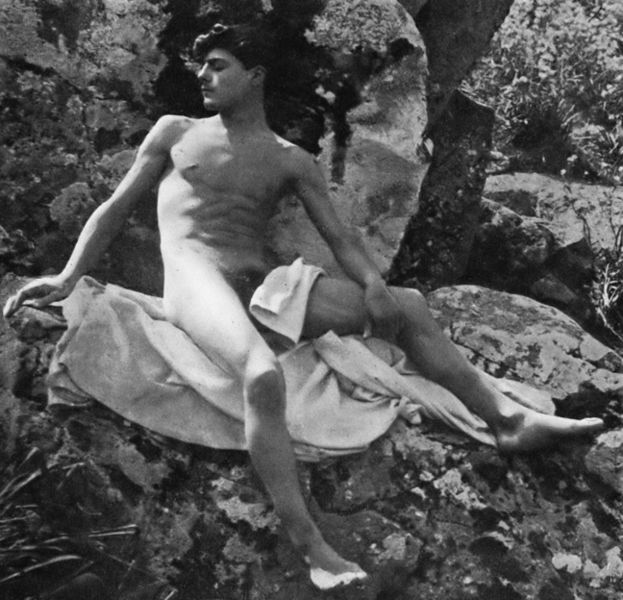 The Count in all his glory (Click for larger) Lord Lyllian, published in 1905, is one of d'Adelswärd-Fersen's novels and perhaps his most important work, satirizing the scandal around himself in Paris, with touches of the Oscar Wilde affair thrown in for good measure. The hero, Lord Lyllian, departs on a wild odyssey of sexual debauchery, is seduced by a character that seems awfully similar to Oscar Wilde, falls in love with girls and boys, and is finally killed by a boy. The public outcry about the supposed Black Masses is also caricatured. The work is an audacious mix of fact and fiction, including four characters that are alter egos of d'Adelswärd-Fersen himself. Akademos: Revue Mensuelle d'Art Libre et de Critique (1909) was d'Adelswärd-Fersen's short-lived attempt at publishing a monthly literary journal. It was magazine of a very luxurious kind, each issue printed on several sorts of deluxe paper, with contributions by many famous authors, like Colette, Henry Gauthier-Villars, Laurent Tailhade, Josephin Peladan, Marcel Boulestin, Maxim Gorky, Georges Eekhoud, Achille Essebac, Claude Farrère, Anatole France, Filippo Tommaso Marinetti, Henri Barbusse, Jean Moréas and Arthur Symons. In each issue, very carefully, as is clear from Fersen's letters to Georges Eekhoud, a homosexual element was introduced: a poem, an article, or a hint in the magazine's serial Les Fréquentations de Maurice by Boulestin. As a magazine with a homosexual agenda, it was the first publication of its kind in the French language. However, only an estimated 10% of Akademos may be counted as homosexual. Thematically, as for the gay part, it trod somewhat similar ground as the German journal Der Eigene, published between 1896 and 1931 by Adolf Brand. This is not a coincidence, as d'Adelswärd-Fersen studied the German publications that tried to push for the social acceptance of homosexuality before launching Akademos. Also, he corresponded with both Brand and Magnus Hirschfeld. Unfortunately, it was published for only one year. D'Adelswärd-Fersen frequently organised parties in his splendid villa, to which all the intellectuals and 'eccentric' travellers staying on the island of Capri were invited. The Baron lived for twenty years on the island; his death there, possibly through suicide, is thought to have been caused by an overdose of cocaine. His ashes are kept in Capri's non-catholic cemetery.
1895 – Robert Tobias "Bobbie" Andrews (d.1976) was a British stage actor. He also briefly appeared in films. Amongst his many character parts was the Prime Minister in Ivor Novello's musical play King's Rhapsody at the Theatre Royal, Drury Lane. When Andrews, who was homosexual, met Ivor Novello in 1916 they became close friends, and eventually lovers. Their relationship lasted 35 years until Novello's death, during which they performed together many times in Novello's musicals and plays.
1898 – Otto Zarek was a German dramaturge , director , writer , critic and journalist. After early expressionist works, he wrote mainly entertainment novels and historical-biographical stories. Zarek was born the son of a factory owner and grew up in Berlin and Plauen . After graduating from high school in 1916 , he first began studying law in Munich, which he soon neglected in favor of his literary and artistic ambitions. Zarek wrote his first drama, Karl V, in 1916 , which was published in 1918; a year later, stories appeared under the title Die Flucht. In 1920 he switched entirely to the theater. He studied directing under Otto Falckenberg and in 1920 became a member of the Max Reinhardt Ensemble in Berlin for a short time. During these years Zarek wrote plays, novels, short stories, essays and radio plays. While in Munich, Zarek met Klaus and Thomas Mann and Bertolt Brecht, among others . In Berlin in 1922 Zarek gave Brecht the opportunity to perform in the cabaret "Wilde Bühne". Zarek himself caused quite a stir in 1930, with his novel Begierde, in which he deals with the subjects of Eros and grappling with homosexuality. Zarek was actually an apolitical author, but as a Jew and homosexual, whose writings were banned, he left Germany after the Reichstag fire in 1933. He emigrated to Hungary. In June 1938 Zarek went to England on a scholarship. Here he wrote his autobiographical report German Odyssey (1941). He joined the British Army in 1940 and served in the British Army Pioneer Corps until 1942 . In 1943 he received the rank of captain in the Political Intelligence Division, and later he worked in the prisoner-of-war division. Between 1945 and 1948 Zarek worked as a senior translator in the BBC's Germany department . After a failed attempt in 1948 to settle in New York, he headed the public relations of Children's and Youth Alliance in London until 1954. Zarek finally returned to Berlin to take over the press department of the Berlin Schiller Theater. Until his death he also worked for various German radio stations, wrote articles for Jewish magazines and organized voluntary cultural events for the Berlin Jewish community.
1911 – Art historian, critic and collector, principally of Cubism, (Arthur William) Douglas Cooper (d.1984) – who also published as Douglas Lord was born to a wealthy family who had made their fortune in Australia generations before. In 1933, he became a partner in the Mayor Gallery in London and planned to show works of Picasso, Léger, Miró and Klee in collaboration with Paris-based art dealers like Daniel-Henry Kahnweiler and Pierre Loeb; however, this collaboration ended fast and unfavourably. Cooper was paid out in works of art. At the outbreak of the Second World War 1939, he acquired 137 cubist works, partly with the help of collector and dealer Dr. Gottlieb Friedrich Reber, some of them masterpieces, using a third of his inheritance. Cooper chose to join a medical unit in Paris when World War II started. His account of the transfer of wounded soldiers to Bordeaux to be shipped to Plymouth achieved some fame when published in 1941 by him and his co-driver C. Denis Freeman (The Road to Bordeaux). For this action, he received a French Médaille militaire. Back in Liverpool Cooper was arrested as a spy because of his French uniform, missing papers and improper behaviour, a treatment for which he never forgave his fellow countrymen. Subsequently, he joined the Royal Air Force Intelligence unit and was sent to Cairo as an interrogator, a job at which he was enormously successful in squeezing out secrets from even hard-boiled prisoners, not least due to his "'evil queen' ferocity, penetrating intelligence, and refusal to take no for an answer, as well as his ability to storm, rant, and browbeat in Hochdeutsch, dialect, or argot, [which] were just the qualifications that his new job required.". He was assigned to a unit trying to investigate into Nazi looted art. He was very successful, his most eminent discovery being the Schenker Papers which made it possible to prove that Paris dealers, Swiss collectors, German experts and museums, in particular the Museum Folkwang in Essen were deeply engaged in looting Jewish property and art as well as building collections for Hitler and Hermann Göring. By 1948, Cooper, a homosexual, had established an abode in London living with Basil Mackenzie, Lord Amulree (1900-1983), a noted physician (Lord). While with Amulree, he met John Richardson, an art historian, and the two paired to become life partners for fifteen years. Cooper and Richardson moved to southern France, where in 1950 Cooper bought the Château de Castille near Avignon, a suitable place to show his impressive art collection, which he continued to expand with newer artists like Klee and Miró. During the following years, art historians, collectors, dealers and artists flocked to his home which had become something like an epicenter of Cubism, very much to his pride. Léger and Picasso were regular guests; the latter even became a substantial part of its life. He regarded Picasso as the only genius of the 20th century and he became a substantial promoter of the artist. At that time Richardson developed an interest in Picasso's portraits and contemplated creating a publication; more than 20 years later, these plans expanded into Richardson's four-part Picasso biography A Life of Picasso. In 1960, Richardson left Cooper and moved to New York City. In 1961, Cooper was found on a road outside Nîmes, heavily injured by stab wounds in the stomach; on his way to the post office in Nîmes to send an article about Picasso's birthday to a London newspaper, he had stopped at a notorious quarter and picked up a young Algerian Fellagha (resistance fighter against the French occupation forces) who had been interned in an open camp nearby. They drove to a lonely area, where the boy drew a knife and demanded Cooper's money or his life. Like most people in France in those days, Cooper carried two purses, one with change and one with large bills. He handed over the first, infuriating the robber, who demanded more money and stabbed him several times. Cooper pushed back his intestines and dragged himself towards the city, his training as a medic proving very useful; against all odds, his cries for help in that lonely area were finally heard, so he could be saved, although he had lost much blood and his intestines were heavily damaged. The culprit was arrested and claimed to have been resisting a sexual assault. In 1972, he adopted his male companion, the 35-year-old William "Billy" McCarty as his son. In 1974, about 20 small paintings by Picasso, Braque and Gris were stolen from his house; and then Cooper foolishly dismissed his old housekeeper and in consequence lost all respect from the neighbours. Afterwards, he relocated to Monte Carlo, mainly for safety reasons, where he led a rather secluded life. Both incidents were reported by major English and French newspapers. Cooper died in London in 1984. He left his art collection to his adopted "son" Billy McCarty Cooper (having adopted him according to French law, in order that nobody else would inherit anything, in particular not his family).
1927 – Roy Cohn, American lawyer and self-loathing homosexual, born on this date (d.1986), became famous during Senator Joseph McCarthy's investigations into Communist activity in the United States during the Second Red Scare. Cohn gained special prominence during the Army-McCarthy Hearings. He was also an important member of the U.S. Department of Justice's prosecution team at the espionage trials of Soviet spies Julius and Ethel Rosenberg. The Rosenberg trial brought the 24-year-old Cohn to the attention of Federal Bureau of Investigation (FBI) director J. Edgar Hoover, who recommended him to Joseph McCarthy. McCarthy hired Cohn as his chief counsel, choosing him over Robert Kennedy, reportedly in part to avoid accusations of an anti-Semitic motivation for the investigations. Roy Cohn spent several decades living a discreet life as a closeted gay man, but when he brought on G. David Schine as chief consultant to Macarthy's staff, speculation arose that Schine and Cohn had a sexual relationship, although some historians have more recently concluded the friendship was platonic. Tall, rich, and suave, the Harvard-educated (and heterosexual) Schine contrasted starkly with the short, physically undistinguished, and caustic Cohn. During the Army-McCarthy hearings, Cohn denied having any "special interest" in Schine or being bound to him "closer than to the ordinary friend." Joseph Welch, the Army's attorney in the hearings, made an apparent reference to Cohn's homosexuality. During the inquiry into Communism and homosexuality in the military, Cohn used a doctored photo of Schine and an Army general to demonstrate the Army's approval of Cohn's bullying attempts to get Schine permanently assigned to McCarthy's committee. Welch insinuated McCarthy's homosexuality by suggesting that a "pixie"—"a close relative of a fairy"—was responsible for altering the photo, implying Cohn himself. Fairy was, and is, a derogatory term for a gay man, The people at the hearing recognized the allusion and found it amusing; Cohn later called the remark "malicious," "wicked," and "indecent." In 1971, businessman Donald Trump moved to Manhattan, where he became involved in large construction projects. Trump came to public attention in 1973 when the Justice Department accused him of violating the Fair Housing Act in his operation of 39 buildings. The government alleged that Trump's corporation quoted different rental terms and conditions to blacks and made false "no vacancy" statements to blacks for apartments they managed in Brooklyn, Queens, and Staten Island. Representing Trump, Cohn filed a countersuit against the government for $100 million, asserting that the charges were irresponsible and baseless. The countersuit was unsuccessful. Trump settled the charges out of court in 1975 without admitting guilt, saying he was satisfied that the agreement did not "compel the Trump organization to accept persons on welfare as tenants unless as qualified as any other tenant.” The corporation was required to send a bi-weekly list of vacancies to the New York Urban League, a civil rights group, and give them priority for certain locations. Several years later (in 1978) the Trump Organization was again in court for violating terms of the 1975 settlement; Cohn called the new charges "nothing more than a rehash of complaints by a couple of planted malcontents." Trump denied the charges. 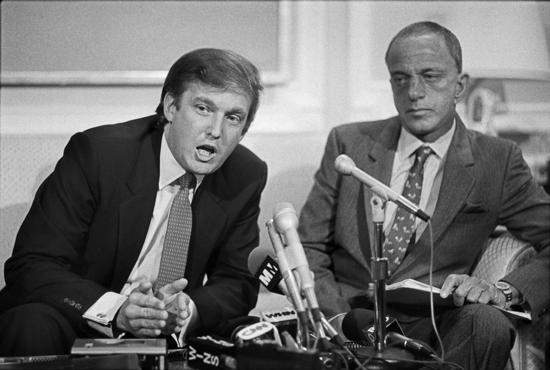 Two of a kind: Trump and Cohn During his checkered legal career, he was several times reprimanded for unethical conduct and sued by disgruntled clients. On three occasions he was tried on various charges, including fraud, but was acquitted. He was ultimately disbarred for financial and ethical improprieties. Cohn never acknowledged his homosexuality, even as he openly frequented gay bars in the 1970s. In 1984, Cohn was diagnosed with AIDS and attempted to keep his condition secret while receiving experimental drug treatment. He participated in clinical trials of AZT, a drug initially synthesized to treat cancer, but later developed as the first anti-HIV agent for AIDS patients. He insisted to his dying day that his disease was liver cancer. Although he had led an extravagantly gay lifestyle during the 1970s, replete with an entourage of handsome "assistants," he continued to deny his homosexuality even as he lay dying of AIDS. He died on August 2, 1986 in Bethesda, Maryland, of complications from AIDS at the age of 59. According to Republican political consultant Roger Stone, for whom Cohn was a role model, Cohn's "absolute goal was to die completely broke and owing millions to the IRS. He succeeded in that." He is buried in Union Field Cemetery in Queens, New York. A dramatic, controversial man in life, Cohn inspired many dramatic fictional portrayals after his death. Probably the most famous is his role in Tony Kushner's Angels In America: A Gay Fantasia on National Themes, in which Cohn is portrayed as a power-hungry hypocrite who is haunted by the ghost of Ethel Rosenberg as he lies dying of AIDS. In the initial Brodway production, the role was created by Ron Liebman; in the 2003 HBO version of Kushner's play, Cohn was played by Al Pacino. Cohn is also a character in Kushner's one-act play, G. David Schine in Hell.
1927 – Count Hubert de Givenchy (d. 2018) was a French fashion designer who founded the house of Givenchy in 1952. He was famous for having designed much of the personal and professional wardrobe of Audrey Hepburn and clothing for Jacqueline Bouvier Kennedy. He was named to the International Best Dressed List Hall of Fame in 1970. His life partner was Philippe Venet. Hubert James Taffin de Givenchy was born in Beauvais, Oise into a Protestant family. He was the younger son of Lucien Taffin de Givenchy, Marquis of Givenchy, and his wife, the former Béatrice ("Sissi") Badin. The Taffin de Givenchy family, which traces its roots to Venice, Italy (the original surname was Taffini), was ennobled in 1713, at which time the head of the family became Marquis of Givenchy. He had an elder brother, Jean-Claude de Givenchy, who inherited the family's marquessate and eventually became the president of Parfums Givenchy. After his father's death from influenza in 1930, he was raised by his mother and maternal grandmother, Marguerite Dieterle Badin, the widow of Jules Badin, an artist who was the owner and director of the historic Gobelins Manufactory and Beauvais tapestry factories. Artistic professions ran in the extended Badin family. Givenchy's maternal great-grandfather, Jules Dieterle, was a set designer who also created designs for the Beauvais factory, including a set of 13 designs for the Elysée Palace. One of his great-great-grandfathers also designed sets for the Paris Opera. He moved to Paris at the age of 17, and he studied at the École des Beaux-Arts. Givenchy's first designs were done for Jacques Fath in 1945. Later he did designs for Robert Piguet and Lucien Lelong – working alongside the still-unknown Pierre Balmain and Christian Dior. From 1947 to 1951 he worked for the avantgarde designer Elsa Schiaparelli. In 1952, he opened his own design house at the Plaine Monceau in Paris. Later, he named his first collection "Bettina Graziani" for Paris's top model at the time. His style was marked by innovation, contrary to the more conservative designs by Dior. At 25, he was the youngest designer of the progressive Paris fashion scene. His first collections were characterized by the use of rather cheap fabrics for financial reasons, but they always piqued curiosity through their design. Audrey Hepburn, later the most prominent proponent of Givenchy's fashion, and Givenchy first met in 1953 during the shoot of Sabrina. He went on to design the black dress she wore in Breakfast at Tiffany's. He also developed his first perfume collection for her (L'Interdit and Le de Givenchy). Audrey Hepburn was the face of that fragrance. This was the first time a star was the face of a fragrance's advertising campaign, and probably the last time that it was done for free, only by friendship. Givenchy retired from fashion design in 1995. His longtime partner was fashion designer Philippe Venet. Hubert de Givenchy died in his sleep at the Renaissance chateau near Paris on Saturday 10 March 2018. He was 91 and was buried in Passy Cemetery in Paris.
1934 – Dale Olson (d.2012) was an American writer and publicist who represented prominent actors and films directors during his career. His notable clients included Dyan Cannon, Tony Curtis, Robert Duvall, Clint Eastwood, Alfred Hitchcock, Rock Hudson, James Earl Jones, Gene Kelly, Sally Kirkland, Walter Matthau, Shirley MacLaine, Steve McQueen, Marilyn Monroe, Sir Laurence Olivier, Diana Rigg, Doris Roberts, Steven Spielberg, Jean Stapleton, Rod Steiger, James Whitmore, and David L. Wolper. Olson also represented industry organizations such as the Producers Guild of America and the Center Theater Group of the Ahmanson Theatre. He served on the public relations coordinating and executive committee for the Academy of Motion Picture Arts and Sciences for twenty years, including three years as the committee's chairman. He also spearheaded and launched film publicity campaigns beginning in the 1970s. Olson was born on Fargo, North Dakota, and lived in Portland, Oregon. He worked as a newspaper reporter as a teenager. One of his earliest interviews was with actress Mae West. Olson moved to Los Angeles in 1951 and became the first national secretary for the Mattachine Society. He worked as a reporter and writer for The Hollywood Reporter and Variety Magazine during his early career. Olson co-founded the Los Angeles Drama Critics Circle as a staff member at Variety. In the 1960s, Olson joined the staff of Rogers & Cowan, a Los Angeles public relations firm, where he remained for eighteen years. He eventually became the head of Rogers & Cowan's film division. Olson left the company in 1985 to open his own publicity company. He became the spokesperson for Rock Hudson in 1985 during the actor's public battle with AIDS. Olson found himself in the middle of a media storm when reporters began raising questions about Hudson's health after the actor appeared shockingly gaunt at a public appearance with his former leading lady, Doris Day. Olson persuaded Hudson to publicly admit his diagnosis with the disease. "I spoke to him and said, 'You have a terminal disease. This is going to affect a lot of people. And you can be the person who can make people aware of it,' " Olson said. Hudson became the face of the dreaded malady. His message, written by Olson, stirred the audience at a 1985 Hollywood benefit for AIDS organized by actress Elizabeth Taylor. In the letter read by fellow actor Burt Lancaster, Hudson said: "I am not happy that I am sick. I am not happy that I have AIDS, but if that is helping others, I can, at least, know that my own misfortune has had some positive worth." He died a few weeks later. In addition to representing actors and other figures, Olson also worked on the campaigns for major Hollywood films. He launched the publicity campaigns for several Hollywood film franchises during the 1970s, including Rambo, Halloween, Rocky, and Superman. He also headed the Academy Award campaigns for many films, notably Terms of Endearment in 1983, American Beauty in 1999, and Gladiator in 2000. The Actors Fund of America named the lobby of its Los Angeles headquarters in honor of Olson and his partner, Eugene Harbin, in November 2004. Actress Shirley MacLaine presented Olson with the Actors Fund Medal of Honor, the organization's highest honor, on July 12, 2012. Dale Olson, a resident of the Hollywood Hills, died from cancer at a nursing home in Burbank, California, on August 9, 2012, at the age of 78. He was survived by his partner of thirty years, publicist Eugene Harbin.
1939 – The Indiana Supreme Court rejects the contention of a man and woman convicted of sodomy that oral sex only between people of the same sex is sodomy.
1943 – Joel D. Weisman (d.2009) was one of the first to identify a pattern of illnesses that was ultimately diagnosed as AIDS during his work as a general practitioner in the United States. He later became an advocate for the development of treatments and prevention of the disease. Weisman was born in Newark, New Jersey on February 20, 1943. He attended the Kansas City College of Osteopathy (later known as the Kansas City University of Medicine and Biosciences, graduating in 1970. He practiced medicine in his hometown of Carteret, New Jersey for several years and ended his brief marriage by disclosing that he was gay. He moved to Los Angeles and was hired by a doctor's office in North Hollywood, where he started to see a number of patients in 1978 who had a series of unusual conditions, including younger men with shingles, a case of Kaposi's sarcoma, and several patients who had symptoms of what appeared to be, but was not, lymphoma. In 1980, a series of patients came to a medical office he had opened in Sherman Oaks, all gay men who had a pattern of what appeared to be immune system disorders exhibited by significant loss of weight and swollen lymph nodes, accompanied by fever and rashes, in addition to two patients with chronic diarrhea, depressed white blood cell counts and fungal infections. Weisman referred two of these cases in 1981 to Michael S. Gottlieb, an immunologist at the UCLA Medical Center, who had a patient of his own with a similar pattern of symptoms. Weisman recollected that he knew going into this meeting that these cases "represented was the tip of the iceberg" and that there were "a lot of people that were potentially right behind them". Gottlieb diagnosed these and a number of his other patients as having pneumocystis pneumonia. A report they jointly wrote published by the Centers for Disease Control in the June 5, 1981, issue of its Morbidity and Mortality Weekly Report, describing how their patients, "5 young men, all active homosexuals, were treated for biopsy-confirmed Pneumocystis carinii pneumonia at 3 different hospitals in Los Angeles, California" of which "[t]wo of the patients died" by the time of the original report. This notice has been recognized as the first published report marking "the official start" of the AIDS pandemic and as "the first report on AIDS in the medical literature". A more detailed report regarding the pneumocystis pneumonia found in a series of four patients was published in a December 1981 issue of the New England Journal of Medicine. Weisman immediately started warning his patients that the diseases was sexually transmitted and that behavioral changes were needed to help prevent its spread, a warning that was often disregarded and resulted in the deaths of many friends. He became involved in efforts to provide treatment options for AIDS patients, establishing AIDS Project Los Angeles in 1983 and developing Southern California's first AIDS unit at the Sherman Oaks Hospital. When amfAR was founded in 1985 by Gottlieb and Mathilde Krim, Weisman was a board member and became chairman from 1988 to 1992. His medical practice grew into the Pacific Oaks Medical Group, one of the largest treating patients with HIV / AIDS. In Weisman's obituary in the Los Angeles Times, Gottlieb described him as "a very astute physician" who recognized "that something out of the ordinary was happening" by being "alert to unusual symptoms in his patients". Krim described how Weisman immediately knew that "he was observing something that was never seen before." Weisman died at age 66 due to heart disease on July 18, 2009, at his home in the Westwood neighborhood of Los Angeles. He was survived by his domestic partner of 17 years, Bill Hutton, as well as by a daughter and granddaughter, a brother and two nieces. Timothy Bogue, his partner for 10 years, died of AIDS in 1991.
1947 – Adrianus Marinus Kyvon (born Adrianus Marinus Kloot), known by his stage name André van Duin, is a Dutch comedian, actor, singer-songwriter, author, television presenter, television director, television producer and screenwriter. Van Duin is one of the Netherlands' best known entertainers, with a career spanning almost six decades. Van Duin was born as Adrianus Kloot, but with "Kloot" being a Dutch slur, he took the name "André van Duin" instead, while his family officially changed their surname to "Kyvon". Van Duin grew up in Rotterdam, was interested in performing at a young age and developed an image as the class clown, partially due to his red hair. After primary school, he went to the LTS to become a machinist, but later worked as an office clerk and a warehouse employee. In 1964, Van Duin achieved his great breakthrough. He entered AVRO's talent contest Nieuwe oogst, which showcased new musical talent to the Dutch public. Van Duin entered the show as recording parodist. During the first show, he playbacked to a self-made six-minute mixed recording of American and British hit songs, his own jokes and imitations of other artists, and hysterical laughter. Van Duin finished the act with imitating a chicken dance in a circle parodying "Surfin' Bird", which had been a hit the year before. After the good response to his first television show, theatre producer Joop van den Ende cast Van Duin for a revue production. Initially, Van Duin would play the straight man to Frans van Dusschoten, but during the try-outs, Van den Ende decided that Van Duin was better suited to play the role of the everyman. During the 1980s Van Duin stayed unchangingly popular as a comedian in the Netherlands. In the mid-1980s he became especially known for several of his alter egos, which he sometimes performed alongside Corrie van Gorp. In 1981, he presented the Flip Fluitketel Show as his alter ego Flip Fluitketel, which at its peak attracted an estimated 5.8 million viewers. In 1986, Van Duin made short pieces of comedy while narrating zoo animals in a show he named Animal Crackers, which was subsequently entered into the Rose d'Or festival. In 1988, Animal Crackers got its own television show in collaboration with the World Wildlife Fund. In February 1988, Animal Crackers was the third-most viewed programme with a market share of 34%. André van Duin was in a relationship with Wim van der Pluym from 1974 until 1995, when Van der Pluym died. Van Duin married Martin Elferink on 23 December 2006. Van Duin put his activities on hold in late 2019 due to the illness of his husband. Van Duin's husband died in early 2020.
1948 – John Browne, Baron Browne of Madingley, is a British businessman. He is best known for his role as the chief executive of the energy company BP between 1995 and 2007. This period has been described as the company's "golden period of expansion and diversification." He resigned from BP in May 2007 in controversial circumstances surrounding his personal life. Being one of the most acclaimed CEOs in the UK and in the world oil industry John Browne, former head of BP, is considered the person who brought the company into its "golden age" though safety and health violations following an investigation of the fatal explosion at BP's Texas City, Texas, plant on 23 March 2005 that killed 15 workers and injured more than 170 others, resulted in fines and awards being given out.. After he had become BP’s CEO in 1995 the hitherto unremarkable oil company set on a course for future grandeur. Under Browne’s leadership BP merged with American Amoco and managed to make the most of its investments in Russia by establishing a joint enterprise with one of the local majors, TNK. He is also known to be the mastermind behind the rebranding of British Petroleum in 2000 which was supposed to distance the company from a plethora of unpleasant associations which are inevitably evoked by those involved with extractive industries. Since then the company officially acquired its current name of BP and traded its shield-shaped logo for a more environmentally friendly green sun. However, Browne’s path to glory was not always covered with rose petals. A few notorious accidents on BPs production facilities took place on his watch. In 2005 the Texas City Refinery owned by BP exploded, claiming 15 lives and injuring ten times more. The following year corrosion of BP’s oil transit pipeline in Alaska led to a significant spill. There was also intense public scrutiny of the company’s business practices in Colombia and Angola. Still, it was not any of those issues that led to Browne’s resignation in 2007. It was his ex-boyfriend, Jeff Chevalier, selling the story of their relationship to the British tabloid, Daily Mail and Browne’s attempt to put a lid on it by getting a temporary injunction on the publication and his subsequent lying to the court about the circumstances of their meeting. As the situation spiraled out of control Browne eventually resigned. At the time he faced allegations that he had supported his partner, Canadian Jeff Chevalier, throughout their four-year relationship, and when Chevalier moved back to Toronto at the end of the relationship, that Browne paid for 12 months of a lease on an apartment. Browne says he felt under pressure to resign due to UK newspaper Mail on Sunday's revelations about his personal life and relationship with Chevalier. As part of a statement made at the time of his resignation, he commented: "In my 41 years with BP, I have kept my private life separate from my business life. I have always regarded my sexuality as a personal matter, to be kept private. It is a matter of deep disappointment that a newspaper group has now decided that allegations about my personal life should be made public." A court accepted that Browne had lied over how he met Chevalier. In a deposition to the court, Browne said the pair had met in a London park; Browne's associates later acknowledged that he had actually met Chevalier via a website called Suited and Booted. However, Mr Justice Eady, the presiding judge in the case, said he decided not to refer the matter to the Attorney General, seeing disclosure in the judgement of Lord Browne's behaviour as "probably sufficient punishment", and adding Browne's "willingness to tell a deliberate lie to the court, persisted in for about two weeks, ... is relevant in assessing his own credibility and the overall merits. So too is his willingness casually to 'trash’ the reputation of Mr Chevalier and to discredit him in the eyes of the court" Today, John Browne is Partner with Riverstone, a private equity firm focused on the energy industry. In 2014 he published his third book called, The Glass Closet: Why Coming Out Is Good Business in which he presents a compelling case for a more tolerant business environment. In an interview OFF | THE | RECORD John Browne recalled how it felt to reach out for Mrs. Thatcher’s help after her introduction of homophobic laws, explained why he believes that even developed societies can turn intolerant, and claimed that he has forgiven his former boyfriend.
1953 – Gérard Araud is a French diplomat, who since 2014 has served as Ambassador of France to the United States. He has also served as France's Permanent Representative to the United Nations as well as Director General for Political and Security Affairs of the French Ministry of Foreign Affairs and International Development. Gérard Araud was born in Marseille. He holds engineering degrees from the École polytechnique and the École nationale de la statistique et de l'administration économique. Araud graduated from the Institut d'études politiques de Paris and is also an alumnus of the École nationale d'administration (class of 1982). Araud joined the French delegation to the North Atlantic Council (NATO) in Brussels in 1995 as Deputy Permanent Representative. He became Director for Strategic Affairs, Security and Disarmament at the Ministry of Foreign Affairs in 2000. He was Ambassador of France to Israel from 2003 to 2006. In September 2006, Araud was appointed Director General for Political Affairs and Security, Deputy Secretary General of the Ministry of Foreign Affairs. On July 15, 2009, he was appointed Permanent Representative of France to the Security Council and Head of the Permanent Mission of France to the United Nations. He presented his credentials to Ban Ki-moon, United Nations Secretary-General, on 10 September 10, 2009. He served as the President of the Security Council in February 2010, May 2011, August 2012, and December 2013. On July 23, 2014 Araud was appointed Ambassador of France to the United States by presidential decree. On the night of the election of Donald Trump as President, Araud tweeted: "It is the end of an era, the era of neoliberalism. We don't yet know what will succeed it," followed by: "After Brexit and this election anything is possible. A world is collapsing before our eyes. Vertigo." Right-wing French political activists, reading this as an undiplomatic expression of dismay at the result, called for Araud's dismissal. On Pearl Harbor Day in 2017, Araud lodged a political insult against the United States by issuing a tweet that said, "In this Pearl Harbor day, we should remember that the US refused to side with France and the UK to confront the fascist powers in the 30s." After the tweet was met with criticism, Araud deleted it and attempted to clarify his remarks. Araud is openly gay and supports same-sex marriage. His long-time partner is photographer Pascal Blondeau.
Dugas traveled the world and had myriad sexual liaisons with other men. At the time, gay culture was largely illegal, underground, and clandestine. Gay bars and gay bath houses were social settings for gay and closeted men to meet. The extent to which HIV/AIDS was known about in the early 1980s, how it was spread, or when Dugas was diagnosed are disputed. Dugas is featured prominently in Randy Shilts's book And the Band Played On: Politics, People, and the AIDS Epidemic (1987), which documents the outbreak of the AIDS pandemic in the United States, and was portrayed by Jeffrey Nordling in the 1993 HBO film adaptation. Shilts portrays Dugas as having almost sociopathic behavior by allegedly intentionally infecting, or at least recklessly endangering, others with the virus. Dugas is described as being a charming, handsome sexual athlete who, according to his own estimation, averaged hundreds of sex partners a year. He claimed to have had over 2,500 sexual partners across North America since becoming sexually active in 1972. Genetic analysis of HIV provides some support for the Patient Zero theory. Dugas is now believed to be part of a cluster of homosexual men who traveled frequently, were extremely sexually active, and died of AIDS at a very early stage in the epidemic. Dugas died in Quebec City on March 30, 1984, as a result of kidney failure caused by AIDS-related infections.
1959 – The Idaho Supreme Court upholds the sodomy conviction of Gordon Larsen, one of the Boise victims, despite inflammatory remarks by prosecutors at his trial. The U.S. Supreme Court refuses to review the decision.
1965 – Philip Hensher is an English novelist, critic and journalist. Hensher was born in South London, although he spent the majority of his childhood and adolescence in Sheffield. He did his undergraduate degree at Lady Margaret Hall, Oxford, before attending Cambridge, where he was awarded a PhD for work on 18th century painting and satire. Early in his career he worked as a clerk in the House of Commons, from which he was fired over the content of an interview he gave to a gay magazine. He has published a number of novels, and is a regular contributor, columnist and book reviewer for newspapers and weeklies such as The Guardian, The Spectator, The Mail on Sunday and The Independent. His sixth novel was a big, gay-inclusive panorama of Sheffield called The Northern Clemency. Since then he's published another large novel King of the Badgers, memorable for its respectable, bear couple hosting their monthly, drug-dabbling gay orgy the same night the village newcomers have a cocktail party, with some impromptu cross-pollination. In 2013, his novel "Scenes from Early Life" was shortlisted for the Green Carnation Prize, and awarded the Ondaatje Prize. It is based on his husband's childhood against the backdrop of the war of independence in Bangladesh. He is married to Zaved Mahmood, a human rights lawyer at the United Nations.
1967 – Kurt Cobain (d.1994) was an American singer-songwriter and musician, best known as the guitarist, primary songwriter and frontman of the rock band Nirvana. Through his angst-fueled songwriting and anti-establishment persona, Cobain's compositions widened the thematic conventions of mainstream rock music. He was often heralded as a spokesman of Generation X and is considered to be one of the most influential musicians in the history of alternative rock. Born in Aberdeen, Washington, Cobain formed the band Nirvana with Krist Novoselic and Aaron Burckhard in 1987 and established it as part of the Seattle music scene which later became known as grunge. After signing with major label DGC Records, Nirvana found global success with "Smells Like Teen Spirit" from their critically acclaimed second album Nevermind (1991). Although Cobain was hailed as the voice of his generation following Nirvana's sudden success, he resented this, believing his message and artistic vision had been misinterpreted by the public. In addition to "Smells Like Teen Spirit", Cobain wrote many notable songs for Nirvana, including "About a Girl", "In Bloom", "Come as You Are", "Lithium", "Polly", "Something in the Way", "All Apologies", and "Heart-Shaped Box". During the last years of his life, Cobain struggled with heroin addiction and chronic health problems such as depression. He also struggled with the personal and professional pressures of fame, as well as his marriage to musician Courtney Love. In March 1994, Cobain overdosed on a combination of champagne and Rohypnol, and subsequently entered an intervention and underwent a detox program. On April 8, 1994, Cobain was found dead at his home in Seattle at the age of 27; police concluded he had died on April 5 from a self-inflicted shotgun wound to the head. In October 1992, when asked, "Well, are you gay?" by Monk Magazine, Cobain replied, "If I wasn't attracted to Courtney, I'd be a bisexual." In another interview, he described identifying with the gay community in The Advocate, stating, "I'm definitely gay in spirit and I probably could be bisexual" and "if I wouldn't have found Courtney, I probably would have carried on with a bisexual life-style". He also said that he "thought [he] was gay" and "wanted to [...] find a chicken hawk and sell [his] ass". He described himself as being "feminine" in childhood, and often wore dresses and other stereotypically feminine clothing. Some of his song lyrics, as well as phrases he would use to vandalize vehicles and a bank, included "God is gay", "Jesus is gay", "HOMOSEXUAL SEX RULES", and "Everyone is gay". Cobain openly advocated for LGBTQ+ rights, including traveling to Oregon to perform at a benefit opposing the 1992 Oregon Ballot Measure 9, and supported local bands with LGBTQ+ members. He reported having felt "different" from the age of seven, and was a frequent target of homophobic bullying in his school due to him having a "gay friend". Cobain was interviewed by two gay magazines, OUT and The Advocate; the 1993 interview with The Advocate being described as "the only [interview] the band's lead singer says he plans to do for Incesticide", an album whose liner notes included a statement decrying homophobia, racism and misogyny:
"If any of you in any way hate homosexuals, people of different color, or women, please do this one favor for us—leave us the fuck alone! Don't come to our shows and don't buy our records."
2004 – Cambodia King Norodom Sihanouk, constitutional monarch of Cambodia, declares that he thought his country should legalize same-sex marriage. He said that he reached this conclusion after watching footage of same-sex couples marry in San Francisco. He also stated that transvestites should be well-treated in Cambodia.
[{(o)}]|[{(o)}]|[{(o)}]|[{(o)}]| [{(o)}]|[{(o)}] |
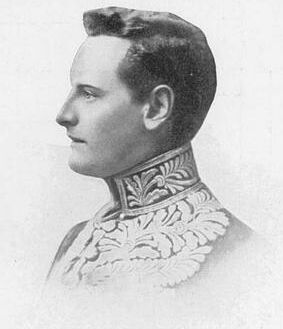
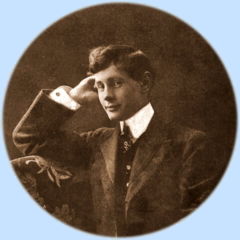
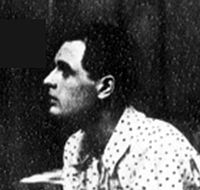
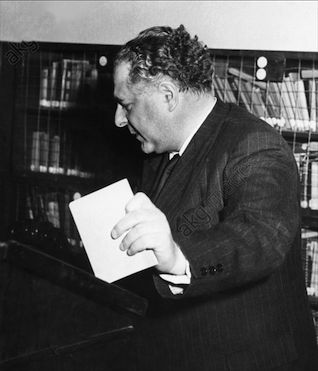

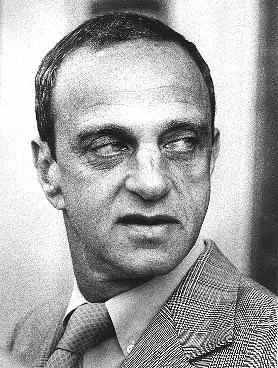
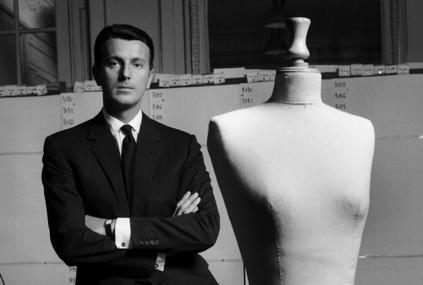
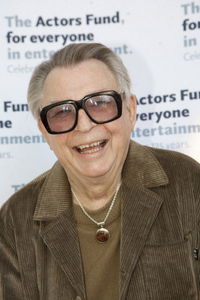
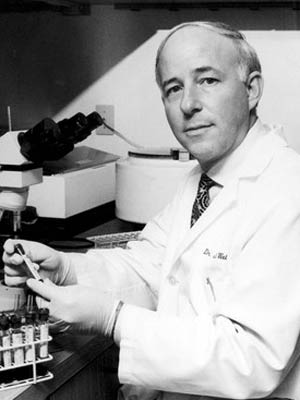
 Added 2023
Added 2023